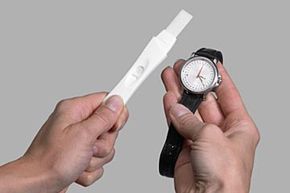For women, finding the most fertile time of the month can be a challenge. A woman's ovary releases one egg per menstrual cycle during a process called ovulation. After it's released, an egg will remain in a woman's fallopian tube for several hours to be fertilized.
This is why couples trying to get pregnant may consider using an ovulation test to determine when a woman is the most likely to release an egg to be fertilized by sperm. If used correctly, ovulation tests can be more than 90 percent effective in signaling when a woman is ovulating [source: FDA]. But while the test will help if you're trying to conceive, they won't help prevent pregnancy. In other words, just because a test does not indicate a woman is ovulating, that doesn't mean she should practice unsafe sex or skip contraceptives during intercourse.
Advertisement
Ovulation occurs about midway through an average menstrual cycle, which usually spans 28 days in length. During this time, a woman's brain releases specific hormones that stimulate her ovarian follicle to release an egg. One chemical called luteinizing hormone (LH) acts as the primary hormone to produce this change.
Most ovulation tests measure LH in a woman's urine, and resemble basic sticklike pregnancy urine tests. Since LH "surges," or suddenly increases, in a woman's body one to two days before an egg is released, these tests give couples a time frame to have intercourse and increase the chance of conceiving a baby. Much like traditional pregnancy tests, ovulation tests produce results within five minutes.
In addition to urine ovulation tests, there are a handful of other ways to gauge whether a woman's at her most fertile. Doctors may use blood tests -- though they are less common -- to assess whether a woman is ovulating.
But because blood tests are still limited to the discretion of health specialists and are not performed at home or without a trained professional, for most women, urine tests are the way to go.
When the time's right, ovulation tests can point couples in the right direction. Read on to learn about when you should start using ovulation tests.
Advertisement
